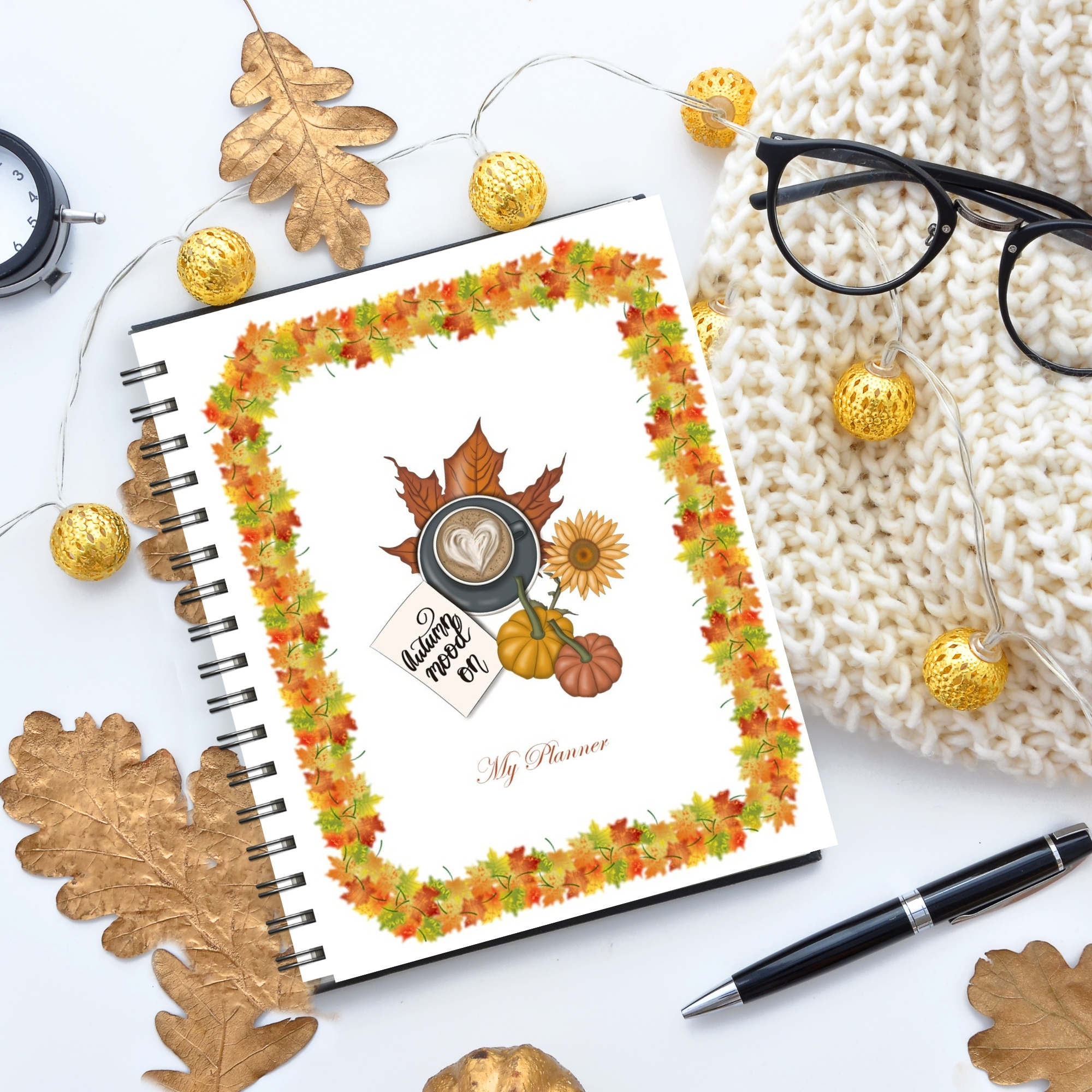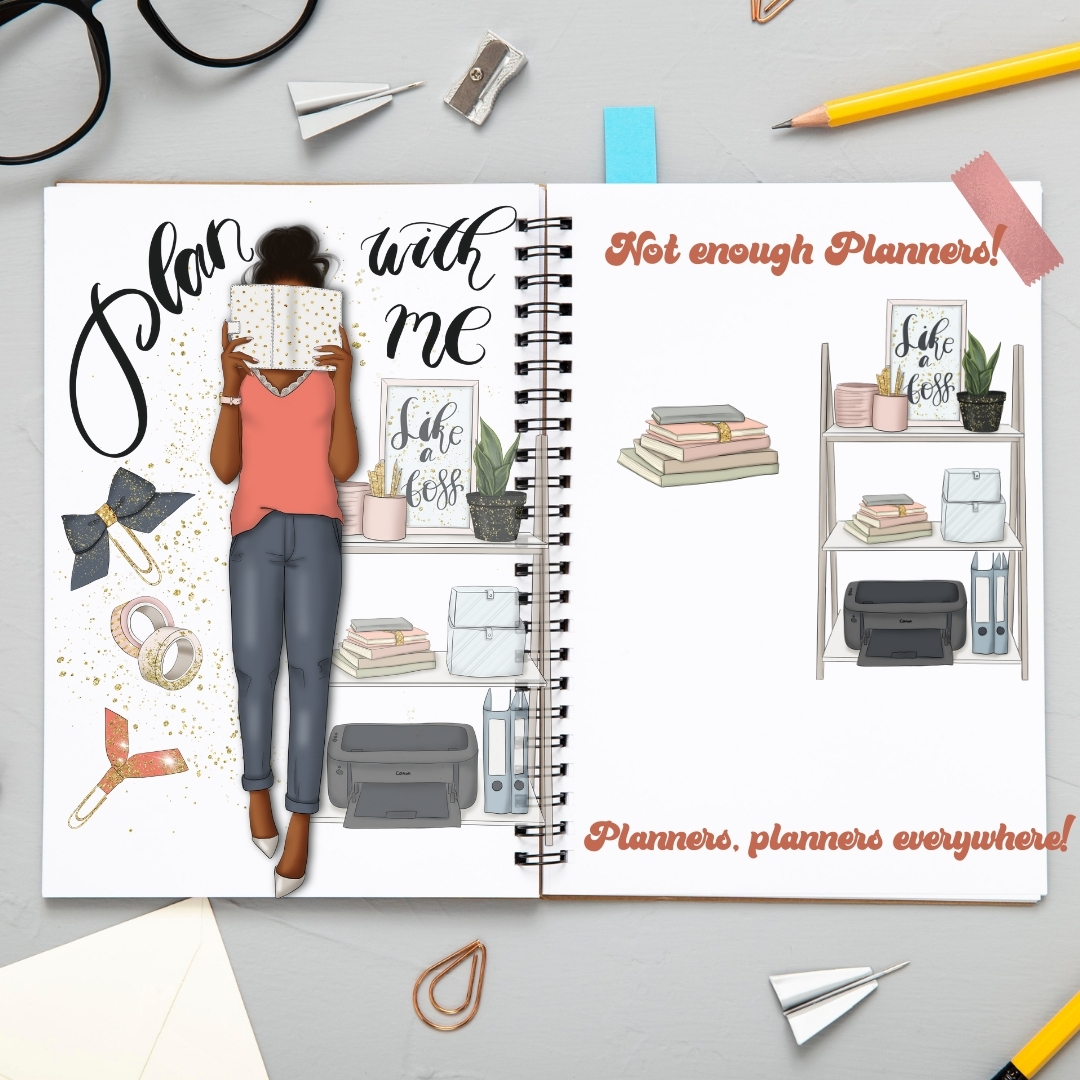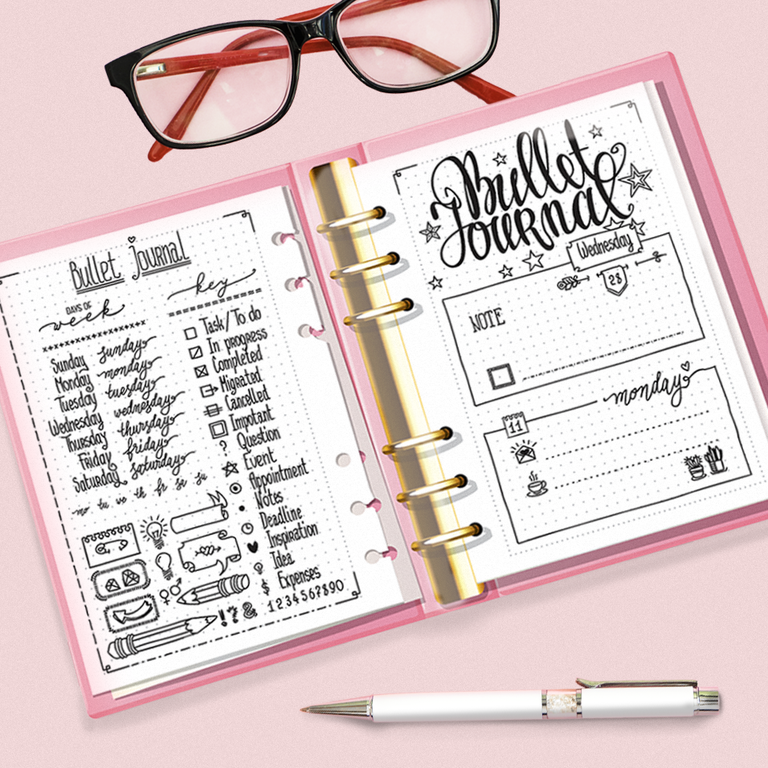Before starting to discuss using a bullet journal in the fall (or autumn if you prefer) season, let’s go over some basics of starting your first bullet journal.
This can be really helpful if you are starting your very first bullet journal, but also a good refresher course even if you have a little experience.
What is a Bullet Journal?
Think of a bullet journal as a way to have a planner, calendar, list of goals and things to do, and all the other aspects of your day in one book. While called a “journal”, it is not written in long paragraphs with all text like a traditional journal would be.
Instead, the bullet journal has different sections that are laid out on the front “Index” page, and most text in the journal uses symbols called “signifiers”.
These allow you to quickly add information to your bullet journal without needing the time and energy for writing long paragraphs, which often take up too much space in this type of journal.
For example, a signifier relating to money coming in or paying a bill might be the $ sign, while you might have a simple checkmark symbol for completing a task.
It is Completely Customizable
One thing to keep in mind about bullet journals is that they are customizable. You should definitely take a look at other journal pages to get inspiration and new ideas for layouts, but you don’t need to copy every page.
The bullet journal is most beneficial when you adapt your own personalization, whether that means the types of pages or collections you include, how they look, the overall layout, or just the colors and design aspects.
It is okay to start simple, then begin customizing it more as you get accustomed to creating new pages.

The First Pages to Start With
It is almost impossible to list all the possible pages you can have in your bullet journal, though there are some that most people will end up using. Here is a look at the first pages to start with, but many more are available for later.
Calendar Pages – No matter what else you have in your bullet journal, you at least want to have calendar pages. They are what makes a bullet journal a “planner” and are also the very first pages you fill out in the bullet journal.
You will have a variety of calendar pages for each month, including the main monthly calendar, weekly calendar pages with more room for text, and possibly some daily pages if you want to write longer text. The daily pages usually have spots for different information, such as tasks to complete that day, events, appointments, meal planning, and lots more.

Task and To-Do Lists – After the calendar pages are filled out, you will then move on to your task and to-do lists. These are created from your calendar of events to break down what you need to get done before the dates written on the calendar.
Trackers – Tracker pages, such as mood trackers, are great when you are working toward a goal. Maybe you are trying to track your mood to figure out what triggers anxiety or panic attacks, or you are tracking the number of days you have followed with a certain new routine you started.
Collections – The last type of page we want to tell you about is the collection page. These are essentially different types of lists for things you want to do, see, or accomplish. They are completely customizable and might include anything from a list of things to do for your business, to places you want to travel to or movies you want to see.
Adding More Later
Lastly, when you are starting your first bullet journal, you should know that you can always add more pages to it later. This is why most people will use a binder-style journal where you can easily add and remove pages as needed.
There is a combination of store-bought and printable pages that will allow you to personalize them for your own needs.
Future Log
The next part of the bullet journal is going to be your future log. The future log is a great way to plan for the near and distant future. It is meant to give you insight into the month coming up, including events or birthdays, weekend plans, work or school tasks, household errands, and everything else going on in your life.
To create this page, turn to the next two blank pages after the index, and write Future Log at the top of each. Divide both pages into three even horizontal sections. Use these as a six-month Future Log and enter the name of six consecutive months at the top of each of the six divisions. Add the page numbers at the bottom of the page and enter them into the Index.
Monthly Log
The calendar spreads are a big part of the bullet journal, starting with the monthly spread. There are many ways to customize the monthly spread, starting with a monthly log. Many people choose to place this after the Future Log in the bullet journal. Take a look at different templates to see how these spreads are set up

Daily Log
If you want even more space to write what you are doing each day of the month, include a daily spread or daily log as well. Begin the next blank page by writing a date at the top, then begin to write down all of the things you need to get done on that day.
Each one of these items will go into one of three groups: tasks, events and notes. These groups will have their own unique bullet style. For example, Tasks will be bulleted by a single dot; Events by an open circle and Notes with a dash. Obviously, you are free to use any type of bullet that helps you keep your journal in order.
If a task is very important, you should add an asterisk next to the bullet to indicate that it needs to be given special attention at some point in that day. These special bullets, like the asterisk, are known as ‘signifiers’, as they add priority to the bullet.
Collections
If you have notes that you may need for a bigger project and other tasks related to it, you can create a Collection on the next blank page. Collections are a good way to keep certain pieces of information together, or on-going projects or class information. As always, jot the page number at the bottom and Index your Collection.
How They All Work Together
As a new month is approaching, create the pages for the next monthly log just like before, remembering to enter the new pages into the Index. Go through the ending month’s daily log and review the tasks. If you haven’t done so already, cross out the items that you’ve completed.
For those tasks that remain, decide if they still need to be done. If not, you can cross through them. If they can be done in the upcoming month, turn the bullet into a Right-Arrow, then copy the sentence into the new monthly log. If the task or project isn’t due for several months, turn the bullet point into a Left-Arrow and log the information into the month that the work should be done in the future log. This is called Migration.
That’s all you need to do to set up your Bullet Journal.
The bullet journal is there to help you plan and organize your life and activities. It will keep the to-do list for next week or next month in the same location as your schedule for tomorrow. All of your plans are located in one place, easy to find and use whenever you need it.
Benefits of Using a Bullet Journal
Now that you know the basics of what is included in your bullet journal, it helps to understand what the benefits are. There are many different styles of journals, from a daily journal to a gratitude journal, and many other specific topics. With a bullet journal, you can write in it like a regular journal, but the main concept is about organizing and planning your life with it.
As you know, the bullet journal works as a valuable analog asset in a digital world. It’s a way of briefly noting your thoughts, plans, events and other items of importance. It’s different than the traditional idea of a journal in that your thoughts can be jotted down on paper quickly. You’ll use just a few words and bullets (hence the name) and other symbols. No long paragraphs or flowery thoughts.
Some people use their bullet journals as to-do lists, planners, diaries — or a bit of all of those forms of helpful self-communication. No matter how you choose to use yours, here’s what you might gain from the experience.
Clarity
Do you have an ongoing low-level suspicion that you’ve got things to do and you’re falling farther and farther behind? We all do. We’re constantly assailed with the need to get stuff done. But what? And when? And how? Your first step, with a bullet journal, is to simply get it all down in writing. See what you’re up against.
Organization
Your actions are constrained by the time you have to do them. But your life won’t seem so challenging if you know how to react efficiently to the hours and days and months ahead of you.
What you hope to accomplish might be something physical, emotional, or financial. It might be as simple as a daily to-do or shopping list or as ambitious and esoteric as a long-term dream. It’s up to you. But once you can set your tasks or goals or dreams in front of you and start to construct a realistic approach to getting where you need to be, you’ll waste less time and get more done.
Stress Relief
Think about how good you’ll feel when you have a realistic plan of attack in front of you and it all looks doable. That’s what you get with a bullet journal entry — the sense that you’re moving logically forward.
You can see on a single page how realistic it is (or isn’t) to proceed according to plan within the period of time you’ve designated. How does your day or your life look now? Don’t you feel better?
Household Management
You’re the president (or co-president) of your own small operation — your family. Your “employees” don’t always pitch it and can be occasionally disgruntled. Sometimes there’s even disagreement within the management team. The operating budget is never sufficient, and your forecasts of future earnings are often off.
A bullet journal will help you plan your days, schedule play dates, school activities and away games, consider a job change and even plan and budget vacations or a new home purchase and move.
Setting and Meeting Goals
It’s easy to say that you’re going to build a garage, generate new streams of revenue for your business or plan your community’s party. But those are just big blocks of dreams. With a bullet journal you can slice that block into manageable actions.
Take garage-building, for instance. Think of all that’s involved. For starters, you have to plan the size and design, estimate the costs involved and figure out where the money will come from. You need building permits and to interview and select contractors, find and price building materials and schedule time.
A bullet journal lets you calmly and dispassionately figure out all that’s involved, who will do what and the steps you must chronologically take to follow your timeline. You’ll proceed with confidence, constantly updating the job in your bullet journal to correct your plans for new realities.
Of course, I have your back! Just how is that, PopMom(as one of my Youtubers call me!) If you don’t already know, I have a free printables hub that you can access! It is password protected, and you can request your password here!
It is completely free, and you will find all kinds of goodies! Here is a sample of what I have added, and will be adding!


